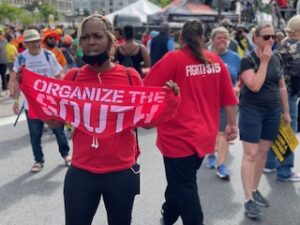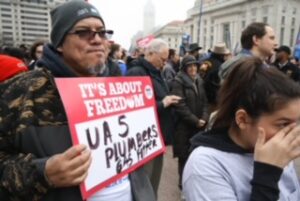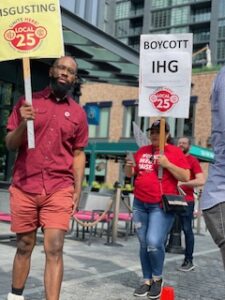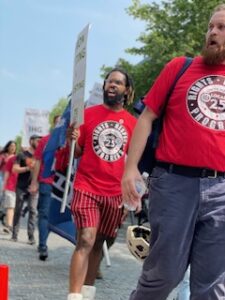Our labor—and the mental, physical and emotional energy it takes to manage it—deserves to be protected. Since the beginning of the pandemic, workers everywhere have begun to make demands to even the playing field by taking bold stances for people over profits..
This year, there has been an increase in workers willing to walk out on the job over wage disparity, poor working conditions and lackluster protections for health care and retirement. All of this comes at a time when employers face a greater need for workers and the popularity of unions hitting its highest level since 1965.
From hospitality to Hollywood hitmakers, from baristas to sanitation workers and engineers to delivery drivers, 2023 is proving to be the year that could change how we view the workplace for a generation.
As Labor Movements Spread Nationwide, White House Highlights How Administration Is Helping Unions
The Cornell School of Industrial and Labor Relations Labor Action Tracker logged 424 work stoppages — which includes 417 strikes and seven lockouts — involving approximately 224,000 workers in 2022.
Despite the coverage of strikes and an administration that claims it is friendlier to unions, membership numbers are still waning nationally. A January BLS report states that 11.3 percent of U.S. workers were represented by a union in 2022, down by 0.3 percent from a year ago. Globalization, automation and the deterioration of legal support to workers over decades has brought down union participation numbers, administration officials said.
Hollywood writers have been striking since early May and have not yet made a deal with the studios. Starbucks workers have unionized at more than 350 stores across the country and a collection of Amazon workers have joined the International Brotherhood of the Teamsters, in hopes of gaining union recognition.
Most recently, auto workers represented by the United Auto Workers union— which still has not endorsed Biden’s 2024 presidential run — voted overwhelmingly to give leaders the authority to call strikes against Detroit car companies Stellantis, General Motors and Ford if a contract agreement isn’t reached.
Photo courtesy of Michael Leslie.
Wage Gains at UPS Have Amazon Workers Demanding More
RAISE THE STANDARD
Workers are taking on the e-commerce giant in one thousand cuts. In a growing unfair labor practice strike, Amazon delivery drivers from Palmdale, California, who joined the Teamsters have extended their picket lines to 10 warehouses in California, New Jersey, Connecticut, Massachusetts, Michigan, and Georgia.
At Amazon’s delivery station DGE9 in Buford, Georgia, 25 warehouse workers came out during their break to meet the Palmdale strikers while they were picketing a nearby Atlanta sortation center, ATL6.
In the parking lot, the workers had an impromptu conversation about shop floor organizing and legal protections that cover collective action.
“We had a real good conversation about our common struggles and what we can do about it,” said one of the delivery station workers, who asked to be anonymous for fear of retaliation.
Since then, the conversation has turned to the UPS contract. “The wages they won have sparked a lot of conversation,” the worker said, and the excitement is spreading to other nearby warehouses. “I just got off a call talking with other workers from Amazonians United Atlanta about trying to catch this lightning in a bottle right now.”
Last October, the Buford delivery station workers presented a petition and walked off demanding a base pay bump of $3, but they only got a 40-cent increase.
“The UPS workers have raised the standard, and we know that’s going to put pressure on Amazon from outside,” said Blundell in Philly. “But if we want to make the gains UPS workers have shown us can be made, we Amazon workers have to be organized from the inside to push this company to treat us with respect, with our wages, with our working conditions.”
FAIR PAY AND SAFE WORKLOADS
Blundell and his co-workers are campaigning across several warehouses in the Philadelphia metro area to demand that Amazon match what UPS Teamsters won, with the aim of taking this demand nationwide.
“We do basically the same work,” he said. “There’s no reason we should be paid so much less by one of the richest companies in the world. If UPS workers had gone on strike, that message would have been shouted from the rooftops.”
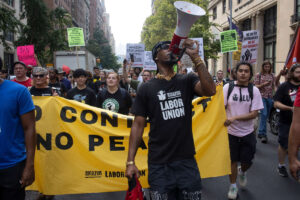
Chris Smalls, a leader of the Amazon Labor Union, leads a march of Starbucks and Amazon workers and their allies to the homes of their CEOs to protest union busting on Labor Day, September 5, 2022, in New York City, New York.
Treasury Touts Labor Unions During ‘Summer Of Strikes’
Following a period of high inflation that was triggered by the pandemic and has led to a cost-of-living crisis for many Americans, popularity for unions has hit its highest level since 1965.
More than 70 percent of Americans now approve of labor unions, a Gallup poll found last year.
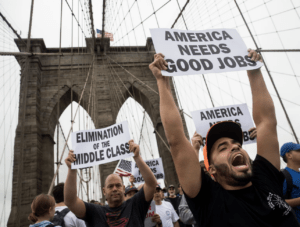
Workers Pay the Price While Congress and Employers Debate Need for Heat Regulations
As this summer has broken heat records, Rep. Judy Chu (D-Calif.) and other members of Congress have pushed legislation that would speed OSHA’s rule-making process. The bill is named after Asunción Valdivia, a farmworker who fell unconscious while picking grapes in California on a 105-degree day in 2004. His son picked him up from the fields, and Valdivia died of heatstroke on the drive home. “Whether on a farm, driving a truck, or working in a warehouse, workers like Asunción keep our country running while enduring some of the most difficult conditions,” Chu said in a July statement urging Congress to pass the bill.
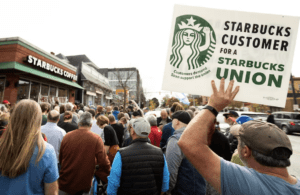
Will Starbucks’ Union-Busting Stifle a Union Rebirth in the US?
With more than 340 victories at Starbucks stores across the US, the campaign to organize the coffee chain’s workers is one of the most successful union drives in a generation. But Starbucks’ fierce union-busting campaign has badly slowed its momentum and exposed deep flaws in US labor law that threaten other promising unionization efforts.
Two years on since workers at a Buffalo Starbucks started the first successful campaign to form a union at a company-run store, labor experts say the coffee chain’s aggressive union-busting is shining a harsh light on the shortcomings of the National Labor Relations Act (NLRA) and how that 88-year-old law which governs unionization campaigns is proving far too weak to stop a powerful, multi billion corporation from using an arsenal of illegal tactics to stifle a highly promising union drive.
Many labor experts say the unionization campaign at Starbucks has done more than any other effort to inspire union drives, whether at Trader Joe’s, Apple or elsewhere, but if Starbucks succeeds in quashing its baristas’ organizing efforts and prevents them from ever getting a first contract, that would be a major symbolic and substantive blow to the hopes for a union rebirth in the US.
Even strong union supporters admit that Starbucks’ “union avoidance” tactics have severely cut into the union’s momentum and win rate.
“Starbucks has figured out an ingenious plan to get around labor law, which is: break so many labor laws so fast that the National Labor Relations Board simply can’t keep up in enforcing the law,” said Jaz Brisack, a fired barista who worked at the first company-run Starbucks – the Elmwood Avenue store in Buffalo – where workers voted in favor of unionizing.
Striking Hollywood writers have rejected a proposal from production studios. The Writers Guild of America says the proposal “failed to sufficiently protect writers from the existential threats that caused us to strike in the first place.” Elaine Low, a staff writer for The Ankler, joined CBS News to discuss.
Related Posts



